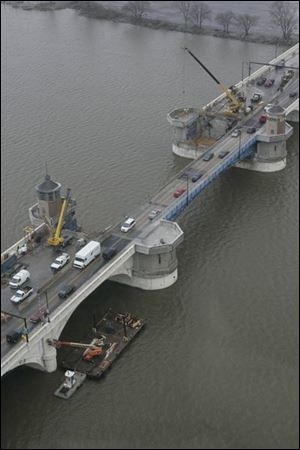
Money woes could delay King bridge completion
8/25/2007
Toledo motorists could be left with just half a bridge, as shown in this photograph, for at least another year, if not longer. Since its reopening in April, the King has been reduced to one lane each way - and with a rough surface, because final paving on the operational half was delayed pending the drawspans' completion. Financial questions also must be resolved.
While work to complete installation of the Martin Luther King, Jr. Bridge's drawspans isn't scheduled to resume until January, the project's financing is on thin ice - again.
The two years that the work already has fallen behind schedule are a primary reason the city now finds itself $5 million to $10 million short of completing the Maumee River drawbridge's reconstruction, Bill Franklin, the city's director of public service, said yesterday.
Just how wide that gap is, Mr. Franklin said, depends on who's talking, because the city disputes $5 million in expenses billed by the contractor, National Engineering, of Strongsville, Ohio.
Resolving that dispute is one of several critical elements that could determine whether the project is finished this winter, he said, because National has threatened not to return to the work site if it isn't paid.
Another vital element is the need to lease heavy-lifting equipment used in barging the prefabricated drawspan sections from a downriver storage yard and jacking them into position at the bridge.
That equipment cost $1.2 million to rent last winter and is in tight supply, meaning that if the city doesn't get its reservation in for this winter, it could end up empty-handed, Mr. Frank-lin said. However, if the city booked the equipment and the money to plug the budget gap wasn't found, the $1.2 million rental would go to waste, he said.
"They want that money up front," Mr. Franklin said. "If we don't pin that down before someone else locks them in [for a project elsewhere], if we don't get those, we don't have a project."
And without a project, downtown Toledo motorists will be left with just half a bridge for at least another year, if not longer.
Since its reopening in April, the King has been reduced to one lane each way - and with a rough surface because final paving on the operational half was delayed pending the drawspans' completion.
City officials have begun discussions with the Ohio Department of Transportation, the Toledo Metropolitan Area Council of Governments, and others about possible funding sources to bridge the budget gap, Mr. Franklin said.
"We're looking wherever we can find it," he said.
Mr. Franklin said it's possible that temporary modifications could be made to render the King more suitable for long-term operation as a two-lane bridge if the funding picture doesn't improve.
But an ODOT response to a city funding inquiry warned that "if the project is not completed as designed, the city may be required to repay the federal funding which has been committed to it."
Michael Ashford, City Council president, said a thorough review of the project's accounting and the city's books is needed to guide decision-making.
"The entire City Council needs to be informed, and there should be a hearing," he said. "Where do we find dollars, and where do we divert that from, to see to it this bridge is completed."
Toledo has spent about $42 million renovating the 1910-vintage King bridge, not including the amount it and National dispute but including the $10 million first phase under which the bridge's concrete-arch spans were refurbished.
National's current contract for replacing the drawspans and associated work originally was valued at $32.3 million, and city officials earlier this year acknowledged a $4.44 million cost overrun, which they attributed to the construction delays.
In its July 17 letter to the city, ODOT said "no more uncommitted funds" exist in the state's Major Bridge Program, which has provided "significant funds" to the project's budget.
David Dysard, ODOT's district deputy director in Bowling Green, suggested that city officials pursue a state bonding program, or ask the metropolitan council about deferring other projects for which that agency administers federal funds and reassigning the money to the King bridge.
Because replacing the bridge's drawspans requires closing the Maumee to navigation, the Coast Guard has restricted the work to the winter months when river traffic typically shuts down.
The replacements originally were to be installed during early 2006, but that was postponed a year after an engineering error delayed their fabrication by a Wisconsin firm.
The drawspans' installation began in January, but its aggressive schedule quickly fell prey to problems discovered with concrete in the drawspans' anchor piers, then to a harsh winter-weather spell that disrupted the barge movements needed to deliver the structures.
Only two of the four drawspan sections were installed before the shipping season resumed.
While city officials expect to recover millions of dollars from a pending lawsuit against HNTB Inc. for the design error that caused the initial one-year delay, they concede any such money won't be received in time to help the current budget situation.
Adam Loukx, a general counsel with Toledo's law department, said the case is preliminarily scheduled for trial in May, but likely will be pushed back.
In October, he said, the city is due to submit its list of expert witnesses.
"I would expect this to be a fairly lengthy case," Mr. Loukx said.
Contact David Patch at:
dpatch@theblade.com
or 419-724-6094.